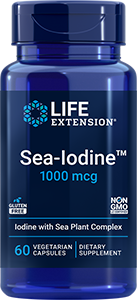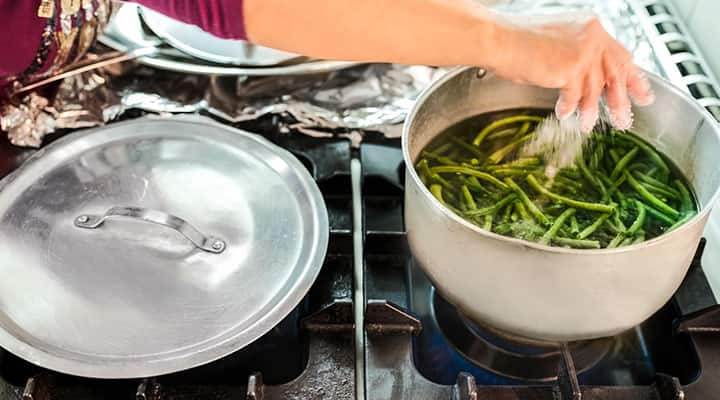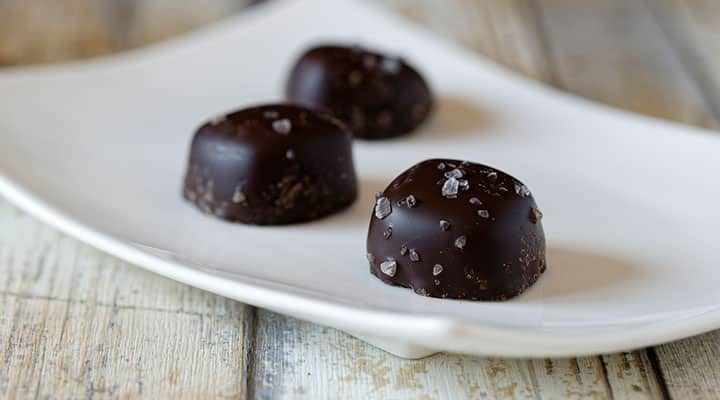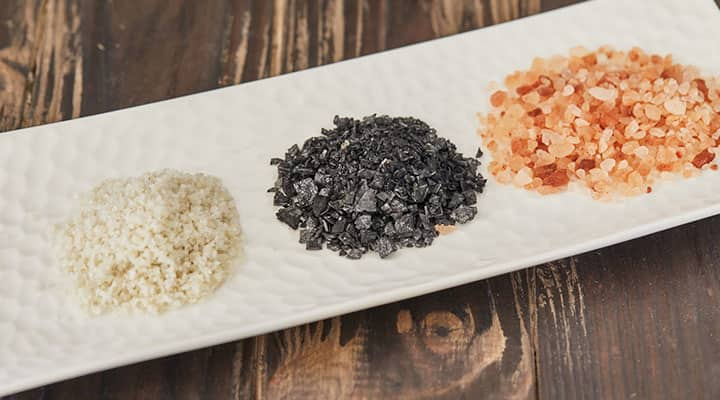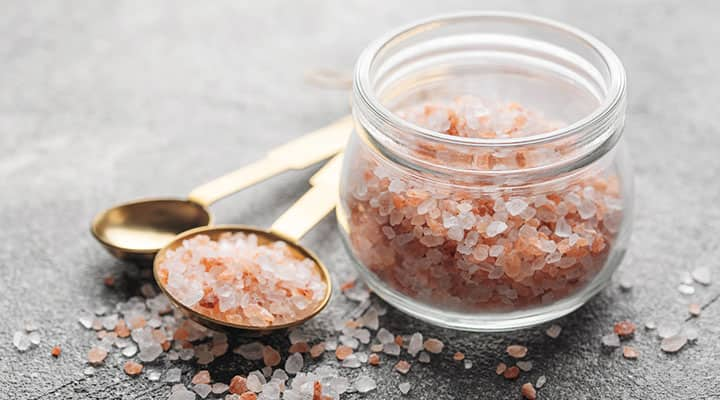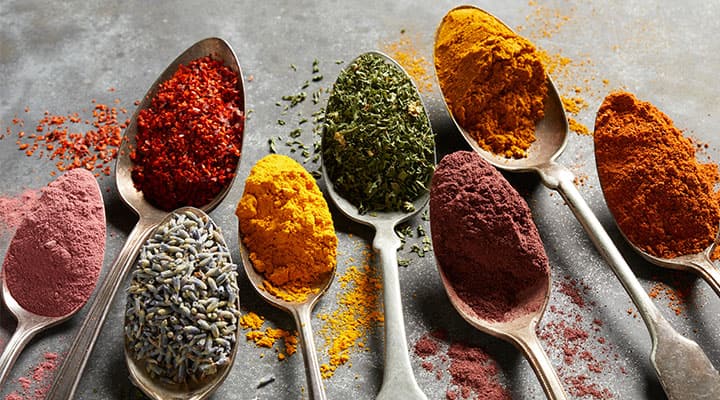
13 Types of Salt: Buying Guide
Published: September 2023
Salt is a crystalline substance that we use to flavor our food. In Roman times, this "white gold" was so valuable that soldiers in the Roman army were sometimes paid in salt (this is where the word "salary" comes from). In Ethiopia, salt blocks were a form of currency. And in the Bible, being referred to as "the salt of the earth" means a person is good, noble and kind.
Salt's reputation sure has changed from those glory days! Mostly because Americans tend to eat it in excess, salt these days tends to be seen as one of those proverbial bad guys, right along with carbs.
Yet we should be taking this shade with "a grain of salt." After all, it can be a source of important minerals, including but not limited to sodium. Sodium from salt plays important roles in the body and helps us maintain homeostasis. And just like many other things we eat, salt can be enjoyed in moderation.
Since it's not just the salt we use as seasoning that adds to our daily sodium intake—many processed foods are a far worse culprit—it actually is possible to sprinkle a little salt on your food without overdoing your salt intake, as long as you're being careful elsewhere in your diet! You can even follow the DASH diet, which limits foods high in sodium to help maintain already-healthy blood pressure, without banishing your salt shaker to the junk drawer.
But with so many different types of salt—from table salt and Kosher salt to more exotic options like Kala Namak and sel gris—it's hard to know which option to sprinkle on your tomatoes, avocado toast, or wherever else you need a little more seasoning! Here are 13 options to consider, plus a guide to choosing the best salt for your needs (and taste buds).
Top 13 types of salt
If you thought there was only one type of salt—or two or three—boy, do we have a surprise for you. There are at least 13 varieties worth their salt, so to speak. Some of them are the basic kind your grandparents probably used (aka table salt). But there are also more exotic options with appropriately exotic names, such as fleur de sel. Plus, various hues and textures of sea salt abound—from pink to black, and from fine to coarse.
So, what's the best salt to choose? Let's explore.
Sea salt
– Sea salt can be produced on an industrial scale all over the world from seawater in large concentrating ponds or on a smaller scale using old-fashioned methods. Gourmet salt makers such as Amagansett Sea Salt gather seawater by hand to make salt for some of New York City's top fine-dining restaurants. Sea salt is a popular choice for everyday use and varies in size and provides a slight briny, ocean flavor and small amounts of minerals. Sea salt is sometimes iodized, depending on the manufacturer.Table salt
– Also known as iodized salt, table salt is what you'll typically find in a salt shaker and is a more processed type of salt that is fine in texture. The fact that table salt is more processed can be considered a downside, as this type often contains additives such as anti-caking agents. On the plus side, though, table salt is enriched with iodine. The practice of adding iodine to salt started in 1924 to help ensure people were getting enough of this nutrient. Iodized salt is still produced today and is one of the only salts that will contain significant amounts of iodine, which is important to maintain healthy thyroid function, support brain health, and promote healthy breast tissue.Kosher salt
– Kosher salt is a coarser-grained type of sea salt that usually does not contain additives and is widely used in cooking. So, what's the difference between kosher salt and sea salt? It actually has to do with its size and shape, and the way this salt is used. Kosher salt gets its name from being used in the process to make meat kosher (according to Jewish dietary laws) by helping to draw out blood from meat.Flake salt
– Flake salt is a type of sea salt to use as a finishing salt that will go great on top of your dark chocolate-dipped treats, not to mention the visual appeal of its pyramid-shaped crystals and the textural crunch it provides!Pink Himalayan salt
– One of the largest salt mines in the world, the Khewra Salt Mine in Punjab, Pakistan, is a major exporter of "Himalayan" pink salt products—which are not just limited to salt, but also the pink salt lamps and décor that you may have in your home. This salt mine produces 800 million pounds of Himalayan salt yearly from remnants of ancient seabeds that crystallized 600 million years ago. The pink color comes from iron. Pink salt is also mined in other places such as Peru and Utah. Due to the higher price point and appealing color, pink salt can also be considered a finishing salt. It's available in fine and coarse textures—and everything in between!Is pink salt healthier than other types? The increase in popularity of this type of salt—due to a supposed nutritional edge over other salts—led Australian researchers to analyze 31 samples of pink salt to determine the mineral composition. Calcium, iron, magnesium and potassium were among the nutritive minerals detected. However, the researchers concluded that "Despite pink salt containing nutrients, >30 g per day (approximately six teaspoons) would be required to make any meaningful contribution to nutrient intake, a level that would provide excessive sodium."
Black Himalayan salt
– Also known as Kala Namak, which means "black salt" in Nepalese, this variety is mined in countries that border the Himalayan mountains. It gets its black color from being cooked in a furnace with charcoal and other ingredients such as herbs, seeds and bark. Interestingly, Himalayan black salt has a history of being used in Ayurvedic regimens. Due to its sulfurous flavor and smell (described as egg-like), it is sometimes used in vegan and egg-free dishes to mimic the taste of eggs.Senegalese pink salt
– Mining isn't the only way to get pink salt. In Senegal, a country in West Africa, 60,000 metric tons of salt are harvested from "Pink Lake," which is known to be even saltier than Israel's Dead Sea. The pink salt produced in this region gets its pink color from the algae. As it dries in the sun, it turns white and iodine is added before packaging.Red Hawaiian salt
– Also known as Alaea salt, this is a type of sea salt that has been mixed with iron containing volcanic clay and is used in Hawaiian cooking. There are other salts that contain clay, including a popular brand among wellness enthusiasts called Redmond Life Real Salt, which is produced from salt deposits and bentonite clay in Utah.Black lava salt
– This type of sea salt from Hawaii is made with activated charcoal. The black hue makes for a fun version of the salted rim for your favorite cocktail or mocktail. Charcoal may benefit digestion, support detoxification, and support the skin and teeth.Fleur de sel
– French for "flower of salt," this artisanal salt is flaky and delicate. It is hand-collected from a thin crust on the surface of seawater ponds during certain times of the year. The salt crystals it yields have been compared to snowflakes.Celtic sea salt
– The name "Celtic" aside, this type of seawater salt, also known as Sel gris, which is French for "gray salt," was originally produced in France. While the Celtic Sea Salt brand says this variety contains various trace minerals, only sodium and iron are listed on the nutrition facts label. This may indicate that minerals other than sodium and iron are present only in very small amounts per serving.Seasoning salt
– Seasoning salt, or infused salt, is salt that is mixed with other herbs and spices to create a blend. A popular example is garlic salt. Pro tip: If you are on a low-sodium diet, choose isolated herbs and spices (such as just garlic powder, without the salt) or a low- or no-sodium seasoning blend like Dash.Rock salt
– Most rock salt is not fit for consumption due to impurities, but some varieties are considered food-grade and can be used for brining. A traditional method of making ice cream includes the use of rock salt and ice that surrounds the ice cream base to help it thicken and freeze (food science is cool, literally!). Additionally, you can use rock salt to make smoked salt, which is produced from smoking either rock or sea salt over a wood fire.
Explore Our Best Heart Health Supplements
What kind of salt is healthiest?
This is a bit of a trick question. We use salt primarily for flavor, not for its stellar nutritional value; even the type of salts that do contain minerals will only provide very small amounts. And there are foods that are considered better sources of these minerals since they will contain higher amounts per serving without the risk of too much sodium. Of course, as is the case everything, which salt is ideal for you depends on your health goals and unique dietary needs. If you are looking for a source of more iodine and don't consume a lot of seaweed and seafood isn't for you, then iodized table salt can be an option.
On the other hand, while there isn't necessarily one "healthiest" salt, there are salts you will want to avoid, not because of the salt itself but because other things you don't want can make their way into the package. Undesirable compounds found in the environment may end up in our salt, including microplastics from the ocean and non-nutritive minerals, so it's important to choose a quality brand that checks for these.
Is Salt Different from Sodium?
Yes and no. The salt that we eat is sodium chloride (chemical formula NaCl) representing sodium and chloride ions—both of which are minerals and electrolytes. Sodium is an essential mineral that plays an important role in the body and impacts cellular function, fluid movement between cells, heart health, our nervous system, and more. There are also other mineral compounds that are considered salts, such as magnesium oxide.
We get sodium from other sources aside from salt. Sodium is used in large quantities in the production of processed foods not only to add flavor but also as a preservative, among other functions. Americans consume on average 3,400 milligrams (mg) of sodium per day—nearly 50% more than the 2,300 mg limit recommended by federal guidelines for people 14 years and older, much of which comes from packaged and prepared foods.
How to buy salt: 6 tips
While there may not be a big difference among (reputable) varieties of salt, from a culinary perspective, it turns out there is a lot to consider when determining which type to use and when to use it:
Appearance
– A crystal of salt comes in a variety of grain sizes (fine, coarse, flaky) and colors (white, pink, blue-grey, black).Mouth feel
– The size of the grain will also provide a different mouth feel, with the larger grains offering texture or some "crunch."Taste
– The surface of your tongue is covered with taste receptor cells more commonly known as taste buds. Humans perceive five basic tastes from the foods we eat: sweet, sour, bitter, umami and, last but not least…salty! But not all salt tastes the same. The mineral composition of the salt can impact the taste. For example, if it has other minerals beyond sodium, it can taste less salty. If it comes from the ocean, brininess and algae can influence and intensify the taste.Nutrient profile
– Aside from sodium, salt can also include other minerals such as iron, potassium, and magnesium. The mineral composition varies depending on the location it is harvested from and how it is processed. Something to be aware of, though, is that non-nutritive minerals (a nice way to say they offer no health benefits and can actually be bad for us) are also found in salt, such as arsenic, cadmium, lead or mercury.Culinary applications
– Salt is used in cooking to flavor, tenderize, brine, cure, pickle or preserve food (one of the oldest uses of salt). Also, salt interacts with other ingredients and helps create the texture of foods such as cheese and bread. Pro tip: check to see which type of salt a recipe calls for or you may end up over-salting or under-salting your dish; chefs recommend weighing salts with a larger grain to ensure accuracy. Otherwise, you will need to determine tablespoon equivalents. For example, 1 tsp table salt (fine) = 1.5-2 tsp of kosher salt (coarse).Production
– The source of your salt matters! Most of the salt we eat comes from underground salt deposits or evaporated seawater. Salt is sometimes mined from the earth's crust or taken from large bodies of water (the ocean) or smaller bodies of seawater such as lakes and ponds. Depending on the method used to obtain salt, salt can be subject to different levels of processing. The more processed production types result in the addition of additives (such as anti-caking agents to avoid clumping) and less naturally occurring minerals, but on the plus side, they generally benefit from the addition of iodine.
References
- Carapeto C, Brum S. "Which Table Salt to Choose?" ResearchGate. January 2018. https://www.researchgate.net/publication/325900969_Which_Table_Salt_to_Choose
- Ciccone T. "How 60,000 Metric Tons of Salt Are Harvested from One of the World's Saltiest Lakes." Eater Video. February 2021. https://www.eater.com/22274514/how-60000-metric-tons-of-salt-are-harvested-from-lake-retba-senegal-africa
- Fayet-Moore F, et al. "An Analysis of the Mineral Composition of Pink Salt Available in Australia." Foods. October 2020. https://www.ncbi.nlm.nih.gov/pmc/articles/PMC7603209/
- Filippou CD, et al. "Dietary Approaches to Stop Hypertension (DASH) Diet and Blood Pressure Reduction in Adults with and without Hypertension: A Systematic Review and Meta-Analysis of Randomized Controlled Trials." Adv Nutr. September 2020. https://pubmed.ncbi.nlm.nih.gov/32330233/
- Narishkin A, Cameron S. "How 800 million pounds of Himalayan salt are mined each year." Business Insider. February 2021. https://www.businessinsider.com/how-800-million-pounds-of-himalayan-salt-are-mined-yearly-2021-2
- Pickens K. "Making Salt for NYC's Fine-Dining Restaurants." Eater Video. June 2018. https://www.eater.com/2018/6/11/17449026/sea-salt-farming-amagansett-video
- "Gustatory System." Michigan State University. 2022. https://openbooks.lib.msu.edu/introneuroscience1/chapter/taste/
- "Mineral Analysis." Redmond Real Salt. https://redmond.life/pages/mineral-analysis

